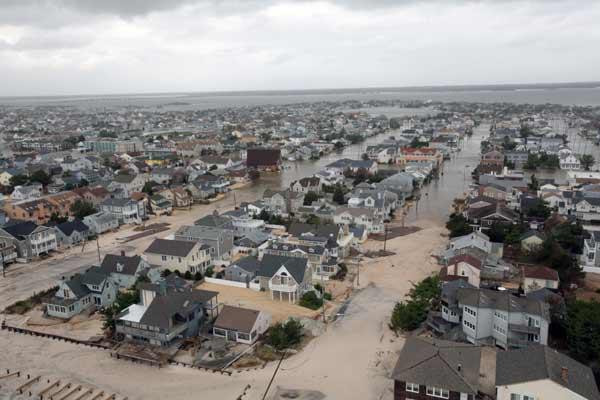In the wake of Hurricane Sandy, the U.S. Navy has ordered three ships to sail off the shores of New York in case federal emergency responders need off-shore support as they continue clean up efforts.
On Oct. 30, "the helicopter carrier USS Wasp (LHD 1), which was already at sea riding out the storm, began to head north to be better positioned," Rear Adm. James Kirby, chief of information for the Navy, wrote on a Navy website.
On Oct. 31, "the fleet commander ordered two other amphibious ships, USS San Antonio (LPD-17) and USS Carter Hall (LSD-50), to get underway and likewise head north … however these ships have not been officially tasked to provide support," Kirby wrote.
The Navy, like the rest of the U.S. military, is often tasked with supporting the Federal Emergency Management Agency in disaster-relief efforts. Navy ships can serve as floating airports as well as provide airlift and SEABEE construction-battalion support.
"It's not out of the ordinary," said Lt. Cmdr. Mike Kafka, a spokesman for U.S. Fleet Forces, explaining that the Navy has sent ships to hurricane-damaged areas in the past to await requests for support from state and federal authorities.
In addition to off-shore support, the Pentagon is airlifting power restoration experts and trucks cross-country, from California to New York, to bolster efforts to assist the millions of people still living in darkness days after Hurricane Sandy hit the East Coast.
C-5 and C-17 military transport planes flew from March Air Reserve Base, Calif., on Nov. 1 and will arrive at Air National Guard Base in Newburgh, New York.
Souther California Edison is sending 62 vehicles to "move out to support efforts to restore power to the stricken region," said Pentagon spokesman George Little. About 100 employees from Southern California Edison will fly out to New York to help restore power to New York residents.
About 4 million homes and businesses were still without power on Nov. 1. Up to 8.5 million lost power during the storm.
"Given the size and scope of the storm and its continuing impact throughout the eastern and northeastern United States, the [Defense Department] is actively posturing forces to support civil authorities via U.S. Northern Command and the National Guard Bureau, with a particular emphasis on un-watering and energy restoration," said Pentagon spokeswoman Cynthia Smith, in an official statement.
Approximately 10,000 Army and Air National Guard forces are on duty supporting the governors in Connecticut, Delaware, Maine, Maryland, Massachusetts, New Hampshire, New Jersey, New York, North Carolina, Pennsylvania, Rhode Island, Virginia and West Virginia.
Guard forces under state control are assembling and staging personnel, providing communications, shelter and engineer support, evacuation and security support, high water vehicle support, high water search and rescue, debris removal and transportation.
Seventeen Air Force cargo planes carrying 69 repair vehicles and equipment from California for use in New York and New Jersey were scheduled to arrive on Nov. 1 at Stewart Air National Guard Base, according to Lt. Col. Tom Crosson, a Guard spokesman.
The aircraft and crews from 12 active duty, Air National Guard, and Air Force Reserve bases flew from March Air Reserve Base, Calif., to pick up approximately 10 passengers and 632 short tons of equipment and supplies supporting relief efforts on the East Coast.
National Guard civil support teams are on stand-by for hazardous material response and providing a Joint Incident Site Communications Capability bridge between first responders and other local, state, and federal agencies.
In West Virginia, where the state received several feet of snow from the storm, the National Guard is patrolling Interstate 68 for stranded motorists and assisting the power company with generators.
At the request of the Department of Health and Human Services, U.S. Transportation Command airlifted approximately 120 medical personnel to New York City to augment medical staff providing care to nursing homes and at-risk elderly patients. Aircraft are on standby to support further missions in response to Hurricane Sandy. Medical personnel are being brought in from Colorado, Ohio, and Texas.
The Defense Logistics Agency is providing fuel, fuel transportation, commodities, and expeditionary teams to support FEMA and the Department of Energy.
The U.S. Army Corps of Engineers' priority is support to the New York City un-watering mission, according to Smith. They have deployed technical assistance, senior leadership oversight, and are working to identify and deploy 100 high volume water pumps consistent with FEMA mission assignments.
USACE is delivering these pumps to New York FEMA Mobilization centers. This is in addition to the 100 water pumps U.S. Northern Command is currently sourcing at FEMA's request.
Other planning response teams remain on alert for debris management, commodities distribution, infrastructure assessment, temporary roofing, critical public facilities, water planning, and temporary housing. Additional temporary power teams have also been placed on alert status.



























